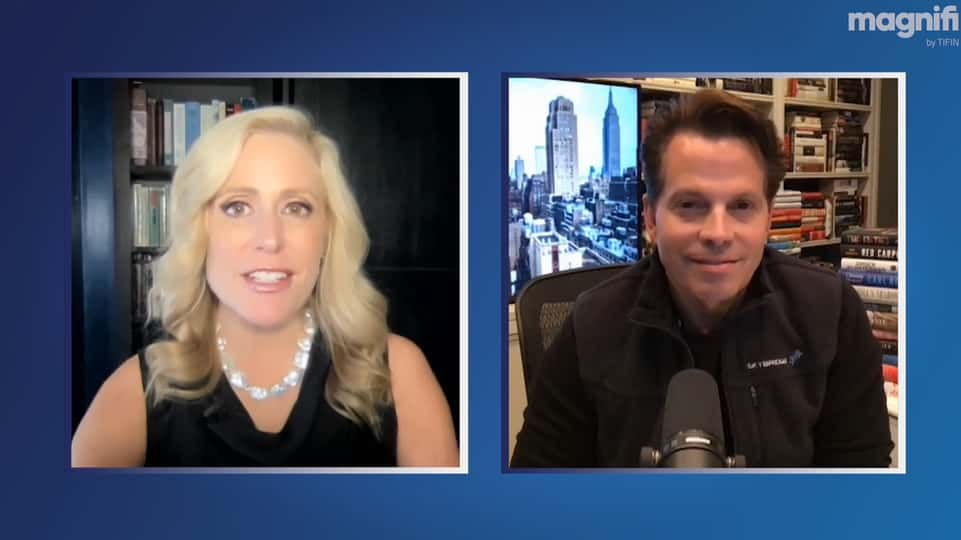SkyBridge Capital Founder, Anthony Scaramucci, joined host Melissa Francis, former CNBC, MSNBC, Fox Business, and FOX News anchor, to delve into the nuances of the digital currency market.
To watch the full interview with Anthony Scaramucci, in addition to interviews with Jeffrey Gundlach, Kyle Bass and Tim Seymour, check out Magnifi by TIFIN.
Melissa Francis: Welcome everyone. Today we’re here to talk about Magnifi by TIFIN, a marketplace where you can harness real time proprietary data to help individual investors and professional advisors identify the best performing stocks, ETFs and model portfolios to grow and preserve your wealth. I’m Melissa Francis. I know a little bit about this. I’m a former CNBC MSNBC Fox Business and Fox News anchor. And right now there is probably no hotter topic out there than crypto, you guessed it. Joining us is Anthony Scaramucci, founder and managing partner at SkyBridge Capital. Anthony, thank you so much for joining us, my old friend, and it’s really good to see you.
Anthony Scaramucci: It’s nice to see you, Melissa.
Melissa Francis: Let’s talk about inflation. Goldman Sachs came out with a note earlier, saying that they think inflation’s going to be even worse than feared, which is kind of amazing because I’m already pretty afraid of inflation. What is your take?
Anthony Scaramucci: I have the opposite take. I could be totally wrong. Obviously, I’m more in line with where the central bank is. I think that there are tremendous transitory issues. I don’t think inflation’s going back below 2% anytime soon, but I think we’ve got probably one more quarter of nasty inflation numbers. But as the supply chain resets itself and the US economy in particular, the global economy at most, but the US economy in particular starts to normalize, you’ll see those inflation numbers come down. And remember you and I both know because we’ve watched this over 20 years. Everybody outsizes their inflation guess because they misestimate, if you will, the deflationary forces of technology. And so, one of the major deflationary forces is the blockchain. This is a hugely layering mechanism. And as you delay and disintermediate and take out third parties from the equation, you are going to dramatically reduce prices.
We have AI, we have the introduction of 5G, nationally and globally. We’ve got, of course, autonomous driving cars. All of this stuff is on the horizon, and is going to push prices down. So I think that you know and I know that we have a tendency to see what’s going on right now and then we think linearly and we say, “Okay, well that’s going to happen next year as well.” I don’t think that’s going to happen. I think we’re going to be surprised at how quickly these inflation numbers drop.
Melissa Francis: I love your points about crypto and especially blockchain. And we’re going to be talking about that a little bit more later, but that was a great perspective. How do you tie that into the Fed? Of course, everybody’s been waiting. In the next couple weeks, they think the Fed is going to tighten out though, I don’t know. With everything that’s going on in Russia, what are your thoughts on the Fed?
Watch the full interview with Anthony Scaramucci HERE
Anthony Scaramucci: Well, again, we have to put it in the perspective of everybody. Let’s just call the 10 year, right now, for the sake of argument, roughly at 2%. And the inflation data is somewhere around seven and a half. And so you have -5.5% real rates in the United States right now, given those numbers. And so if the Fed and Jerome Powell’s already indicated this, this week that he’s going to raise and he’s calling for a 25 basis point increase this month, I think that’s a scant increase. Moreover, people like my friend, Mohamed El-Erian, would’ve argued that they should have gotten way ahead of it. I’ve argued the opposite. There’s still tremendous slack in the system. There’s a lot of people that need to get re-onboarded to a more normalized economy. And I think in retrospect, and people look back on this, they’ll say the Fed did a very good job.
The big issue for everybody is the dollar volume that’s in the system right now. Remember, we’ve got a $9 trillion Federal Reserve balance sheet since April 1st of 2020. We’ve increased the monetary supply, so this would be measured by M2 by 42%. Okay. So that’s an astronomical increase in the amount of money that’s in circulation in the economy, Melissa. And that’s one of the main reasons why we’ve got inflation coupled with the supply chain disruption.
So he’s going to have to start taking that money out of the market. He was doing that successfully in 2017, ’18 into ’19. The market did correct as a result of that, but I think that the good or bad news everyone will look at at the market’s already corrected. So the market’s pricing this stuff in. I think JP Morgan or one of the big banks said it’s going to be seven or eight rate increases. That’s only a 2% increase, frankly, if you’re going at 25% a piece, but my prediction is going to be less than that. I think the overnight rate, by the end of the year, will be probably one and a quarter. I don’t think it gets to 2%. And I think these numbers will come down.
Our big issue right now is going to be, how are we going to resolve this existential crisis that’s happening in Europe because you don’t have to read The Guns of August to know that one mishap could lead to World War III. We’re over the line now, in terms of where we need to be and you saw the nuclear plant explosion. God forbid, if that led to a meltdown of that reactor, that’s the largest nuclear plant in Europe. The wind could blow a certain way. Many people lost their hair in Germany in 1986, as a result of The Chernobyl disaster. Just imagine the wind blowing and heading it towards China, or heading it north to Russia. This is the stuff that happens in war. You’re planning one thing and then the theater of war changes your plans and things become catastrophic. So I’m more worried about the war than I am the inflation.
Melissa Francis: Those are great points. You made a decision after your stint at the White House to pivot SkyBridge, which had been a successful fund of funds, ceding hedge funds to crypto. Now, why did you make that decision then?
Watch the full interview with Anthony Scaramucci HERE
Anthony Scaramucci: Well, listen, when I got fired from the White House, I had written down on my notepad that when I leave, I’ve got to go back to SkyBridge and buy the website, skybridgebitcoin.com, because I had had a few meetings at the EXIM Bank. People don’t remember this, but I was the chief strategy officer at the EXIM Bank for a period of time. And treasury officials had come in to talk about the digitization of the dollar.
Ultimately, Secretary Mnuchin made the decision not to press forward with that, but I thought, wow, just the notion that the United States that has the reserve currency, is thinking about dollar digitization means that there’s something way more to the blockchain than my traditional finance friends and executives thought. I did think I was going to last longer at the White House than a carton of milk in the refrigerator, Melissa, but that’s for another day.
But so after I got blown out of the White House, I immediately bought that website and then I said to my team, “We need to do a lot more work on the blockchain.” Which we did. And then I put a checklist together. I said, if Bitcoin can get through a hundred million wallets, which it did in October of 2020, if Bitcoin could be stored safely in cold storage, I wouldn’t have to worry about the hacking of the things that took place at a BitFinance, as an example, or Mt. Gox.
And then the third thing was regulation. And so I got very comfortable with the first two. We store our Bitcoin at Fidelity and NYDIG. The 100 million wallets, at least according to Glassnode, is now 240 million wallets. And ultimately, I made the decision, rightly or wrongly, that this would be fairly regulated in the west, primarily because the IRS said that Bitcoin was property. It’s treated on your tax return as intangible property. And one of the great things about the US is real property rights. The real property rights are sacrosanct in this country. They date back not to the origination of the United States, but they go back 900 years to British common law.
And it’s very hard, it’s very difficult to take property away from citizens once it’s been deemed property. And, of course, with that you have the right to trade that property. So, obviously, the Bitcoin futures, October of last year, indicated that it’s going in the right direction. I predict, before the end of the year, you’ll have a cash ETF trading in the United States. You already have them in Europe, you have one of several up in Canada. So those things, once the criteria was met, SkyBridge put about $250 million into Bitcoin and Ethereum. We own other coins now like Algorand and Solana. We still have our fund of funds business, it’s a very robust, successful business, but I do think that the world is moving in this direction and I don’t want my clients to miss it.
Watch the full interview with Anthony Scaramucci HERE
Melissa Francis: So your crypto funds First Trust Bitcoin Fund, First Trust Ethereum Fund, and First Trust Crypto Fund, were originally a hedge on inflation, but over the past year, of course, Bitcoin has acted more like an over the counter stock than a hedge on inflation. Did that change the way your strategy or changed the way you looked at these assets at all?
Anthony Scaramucci: So it’s interesting because secretary Mnuchin was interviewed recently and he said, “Is Bitcoin an inflation hedge?” And he said, no, he didn’t see it that way, but he felt that there were use cases for Bitcoin. I have never said that it was an inflation hedge. In fact, when I’ve been on TV or an interview like this, or in my writing, even the book that I wrote about Bitcoin, that I do not see it in its current state as an inflation hedge. I see this as an early adopting technological story that is mirroring a lot of what happened in Web One. And I’ll just give this very quick example: Amazon went public on May 15th, 1997, if you and I were smart enough to put $10,000 in Amazon on that day, it’s worth $21.4 million today. However, we would’ve subjected ourselves to eight periods of time where Amazon dropped 50%, one period of time, chronically, where it went down 90%, but we would’ve had to ride that volatility to get to where we are today.
And very few people can have the stomach for that, but that’s where I see Bitcoin. Bitcoin has 2% or two and a half percent right now, global adoption. It’s an early technological adoption story. It is not yet an inflation hedge. Could it be one? Yes. Melissa, if we get to a billion plus wallets and Bitcoin’s trading at a half a million dollars a coin and it’s stable and it has way less volatility, yes, it could be digital gold, but it’s not that yet. Any more than if you and I were logging onto the internet in 1998, and we were waiting 35 seconds for our homepage to come in and I turned to you, I said, hey, Melissa, someday, you and I are going to be able to stream 4K movies over the internet, but it’s not just going to be you and me. It’s going to be hundreds of millions of people around the world.
We would’ve looked at each other in 1998 and said, are you kidding me? I have this dial up modem and this AOL account that’s not happening, but of course it did. So I just want to remind people about how exponential progress works. We’ll be sitting here, bitcoin will have a billion plus wallets and growing, and hopefully you’ll interview me at that point. And I’ll say, yes, this is an inflation hedge now, due to the saturation, the value and the lack of volatility, but we’re going to be at least five to eight years away from that.
Melissa Francis: So let me bring it all together then. You’ve made a lot of really great market calls when President Trump was elected, not just because of your relationship, you said that you thought the market was going to take off. By the way, I was on television all night that night until the morning, and I said the same thing when the market crashed. It was a screaming buy that morning. Of course, you were right. I was right, but you had skin in the game. Crypto, of course, is down, I don’t know what it is, like 30% from its high? Something like that. But if I’m just an average investor, have I missed that class? What would you do right now if you weren’t in at all, and you were listening to this, what would you do?
Watch the full interview with Anthony Scaramucci HERE
Anthony Scaramucci: I would buy some, is what I would do, but I would also average in. The only way you can handle a technology like this is to dollar cost average in. You said something interesting about the Trump election, I thought it would be insane that the market wouldn’t go up. Okay, whatever I think of President Trump personally, and whatever unfolded between me and him, he had pro-business policies that he was going to put in place that were going to directly affect the market. If you cut rates and you remove the rates from 35 to 22%, you’re increasing earnings by about 40%. And so, therefore, the market should go up by at least 40%. And of course all those things started to unfold. I think this is a different thing. This is early adapting technology. This will be very volatile. There’ll be periods of time where Bitcoin will crash down 50 plus percent.
But if you’re willing to zoom out and look at the long term chart and look at the adoption story, could Bitcoin get to a half a million dollars a coin? I believe it will. Could we have a lot of steps and starts during that period of time? I think the answer is yes. And I can prove that to you, whether it’s Facebook or Amazon or Google, or you pick the stock story. Incumbent in those stories was lots of early stage volatility. Let me just leave you with this one thought, because I think it’s important. If we were talking about Facebook a decade ago, where it had 240 million users, I said, “Melissa, someday Facebook and its counter subsidiaries like Instagram, collectively, were going to have 3 billion users.” Just imagine. Okay. And that’s a very short period of time later. A lot of people would’ve looked at me and said, it’s not ever going to get the 3 billion users, but there it is. Take a look at the Facebook stock chart. Now it got hit recently, but I still think Facebook’s best days are ahead of it. And so are Bitcoins’.
Melissa Francis: To that point, one of the most interesting stories I’ve seen in the past couple days about crypto is how it has played in the Ukrainian war effort. The country put a call out, more than $52 million in donations came in. I think it was as of last Saturday, but you contrast that with when governments are saying, oh, we’re going to send you money. It might get there in a week. But instead, here comes technology, here comes crypto, and the money starts funneling in to help the Ukrainian side. What did you think about that?
Anthony Scaramucci: Well, first of all, I would say, thank God for that. Secondarily, the critics of Bitcoin that are saying, well, now the Russians are going to use it to get around the sanctions. They don’t really understand the nature of it, and how easy it is to track the wallets. The Department of Justice does understand that. They were able to get back several billion dollars that were stolen in the BitFinance thing, the minute they tried to spend that money. They were also able to get back some of the ransomware on the colonial pipeline situation related to Bitcoin.
And there’s a great white paper by Mike Morell, the former CIA director, acting CIA director, about how there’s a misnomer out there that Bitcoin’s good for illegal activities. It’s actually not because it’s very easily traceable, but I like the story of the instant money going into the Ukraine. And I think that is the future. We’re talking about Rao’s, they only take cash at Rao, but most other restaurants take American Express or Visa. Just imagine you and I going to a restaurant that takes a credit card, but someday I can take out my smart wallet and my smartphone. I can direct value to the waiter, into the smart wallet of the restaurant. And I just bypass the 3% fee and MasterCard Visa and American Express charge.
Watch the full interview with Anthony Scaramucci HERE
Melissa Francis: Let me ask you a quick follow up though, because you say that people don’t understand how traceable it is. And of course the average person who’s listening about crypto and everything else, the value of it, we have been taught, is that it’s not traceable. That’s why people use it, because there’s freedom. So explain to us why it is traceable and people don’t think that’s the case.
Anthony Scaramucci: I don’t think that’s the value, but again, everybody’s got a different view of Bitcoin. I think the value in Bitcoin is that it is a direct circuit of transferability. So you and I can transact with each other. We don’t have to know, like or trust each other, but because of the forces on the blockchain, the technical prowess of the blockchain, we both trust that. So I can send value from my wallet to your wallet, it goes unhacked and secure and that transfers made. So that delayering, that cost savings mean not having to bypass through a third party, I think is where the value is. Your wallet is known. My wallet is known. Every single transaction that’s ever happened in Bitcoin is on the ledger. It’s on the open sourced ledger of Bitcoin. And so it’s very easy to trace this stuff.
So people that think that it’s not easy to trace, or things like that, I don’t know where they’re coming from on that. If you said to me, well, that was the case, say 2009 to 2014, I’d say, okay, it was a very small group of users at that point. Maybe it was used for silk road purchases or for drug purchases, but it’s just too scaled now. And it’s too available for scrutiny by the regulators. I want to make this point because I think this is also a very important one to think about when you’re thinking about Bitcoin. If I can send value to you without a third party, I can save a ton of money.
Let me give you the El Salvador example, quickly. Many expats here in the US want to send money back to mom and dad. They’re underbanked. They may go to a Western Union office and say, here’s a thousand dollars, could you please send it to my mom in El Salvador. They get whacked anywhere from 7 to 9%. And so mom gets $920, $1,000 goes into the system, $80 goes to Western Union. Well, because they now have Bitcoin as legal tender, Melissa, the department of commerce in El Salvador expects a $400 million savings by expats giving money back to their family members in El Salvador, bypassing Western union and just going wallet to wallet transfer. And so I think that’s where the opportunity is. And I think that’s ultimately where the future’s going to be in financial services.
Melissa Francis: And one of the words that you mentioned in their blockchain is so important because it’s not just talking about transferring money, it’s also how people can access data. I mean, blockchain really leads to the democratization of asset classes. Talk to me a little bit about that.
Anthony Scaramucci: So I think you’re saying it better than me, actually, but I mean, I’ll just give examples of the blockchain as an empowerment mechanism because the underbanked right now, why are they underbanked? They don’t have enough money to beat the fees at the money center banks or the regional banks, but if they had access to Bitcoin and the blockchain, they could effectively be their own bank. As I just imagine the power of that, I imagine the commercial activity. If you’re talking about the stock market as an example, let’s talk about transactional savings.
Watch the full interview with Anthony Scaramucci HERE
If I’m going to trade my stock and it’s going to end up in your account, it goes through seven entities before it arrives at your door. But over the blockchain, I’ll be able to trade directly with you. And you’ll see real time, within hours of settlement, maybe we’re T+1, or I guess I’m on stocks T+2 at this point, but you’ll get to the point where you have almost instantaneous settlement. And again, think of where we were downloading that homepage in 1998, and think of all these people watching 4K television today, these advancements are going to come very quickly and I don’t want my clients to miss it.
Melissa Francis: You talked about the regulation piece a little bit at the beginning. And you talked about property rights and how that figures in, where do you think regulation of crypto goes from here?
Anthony Scaramucci: Well, honestly, we’re in a… CLICK HERE to watch the rest of this interview at Magnifi by TIFIN
Want More Great Investing Ideas?
BITO shares were trading at $24.21 per share on Monday afternoon, up $0.19 (+0.79%). Year-to-date, BITO has declined -16.23%, versus a -12.30% rise in the benchmark S&P 500 index during the same period.
About the Author: StockNews Staff

The StockNews Staff is led by a team of investment experts including CEO, Steve Reitmeister and trading legend Adam Mesh. The goal of our commentary is to provide you with valuable insights to make more successful investment decisions. More...
More Resources for the Stocks in this Article
| Ticker | POWR Rating | Industry Rank | Rank in Industry |
| BITO | Get Rating | Get Rating | Get Rating |






